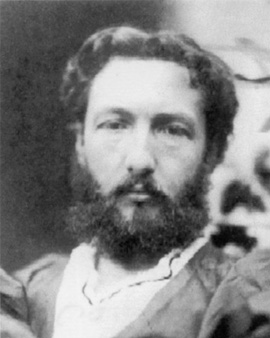At the age of eleven, in 1841, Frederic Leighton, 1st Baron Leighton, was taught painting in Rome and then studied first at the Academy of Berlin, from 1844 in Florence under Giuseppe Bezzuoli (1784 - 1855) and then under Eduard Jakob von Steinle (1810 - 1886) at the Städelsches Kunstinstitut in Frankfurt am Main. The Nazarenes and the painters of the Italian Renaissance had a particularly strong influence on the young Frederic Leighton, one of whom inspired Leighton to paint his first two large paintings: Giotto, Found Among the Sheep by Cimabue (1847) and Cimabue's Madonna Carried in Procession (1852 - 1855). The latter was sent by Leighton to the Royal Academy after its completion and was also his breakthrough as an artist.
Before his return to Rome in 1858 Leighton lived in Paris. During his time in Rome he made four portraits of the Italian model Anna Risi, later lover and muse of Anselm Feuerbach (1829 - 1880). In 1859 Leighton returned to London, where three of Anna Risi's portraits were exhibited at the Royal Academy: Pavonia, An Italian Lady and A Roman Lady. Although Leighton did not consider himself a member of the Pre-Raphaelites, his works were obviously influenced by the group of artists after his return to London.
Leighton rose rapidly within the Royal Academy: in 1866 he was only an associate, in 1869 a member and as early as 1878 president, a task he took extremely seriously.
×





.jpg)
.jpg)
.jpg)
.jpg)
.jpg)
.jpg)
.jpg)
.jpg)
.jpg)
.jpg)
.jpg)
.jpg)
_-_(MeisterDrucke-898076).jpg)
_-_(MeisterDrucke-898076).jpg)
_-_(MeisterDrucke-901926).jpg)
_-_(MeisterDrucke-901926).jpg)
.jpg)
.jpg)
.jpg)
.jpg)
.jpg)
.jpg)
.jpg)
.jpg)
.jpg)
.jpg)
.jpg)
.jpg)
.jpg)
.jpg)
.jpg)
.jpg)
 - (MeisterDrucke-96428).jpg)
 - (MeisterDrucke-96428).jpg)
.jpg)
.jpg)
.jpg)
.jpg)
.jpg)
.jpg)
.jpg)
.jpg)
.jpg)
.jpg)
.jpg)
.jpg)
.jpg)
.jpg)
 - (MeisterDrucke-97889).jpg)
 - (MeisterDrucke-97889).jpg)
.jpg)
.jpg)
.jpg)
.jpg)
.jpg)
.jpg)
.jpg)
.jpg)
.jpg)
.jpg)
.jpg)
.jpg)
.jpg)
.jpg)
.jpg)
.jpg)
 1885 - (MeisterDrucke-237792).jpg)
 1885 - (MeisterDrucke-237792).jpg)
.jpg)
.jpg)
_-_(MeisterDrucke-1131188).jpg)
_-_(MeisterDrucke-1131188).jpg)
.jpg)
.jpg)
.jpg)
.jpg)
.jpg)
.jpg)
 - (MeisterDrucke-228241).jpg)
 - (MeisterDrucke-228241).jpg)
.jpg)
.jpg)
 - (MeisterDrucke-274756).jpg)
 - (MeisterDrucke-274756).jpg)
.jpg)
.jpg)
_-_(MeisterDrucke-1126528).jpg)
_-_(MeisterDrucke-1126528).jpg)
.jpg)
.jpg)
.jpg)
.jpg)
_-_(MeisterDrucke-905906).jpg)
_-_(MeisterDrucke-905906).jpg)
.jpg)
.jpg)
.jpg)
.jpg)
_-_(MeisterDrucke-592568).jpg)
_-_(MeisterDrucke-592568).jpg)
.jpg)
.jpg)
_-_(MeisterDrucke-1497460).jpg)
_-_(MeisterDrucke-1497460).jpg)
.jpg)
.jpg)
.jpg)
.jpg)
.jpg)
.jpg)
.jpg)
.jpg)
.jpg)
.jpg)
 - (MeisterDrucke-243165).jpg)
 - (MeisterDrucke-243165).jpg)
.jpg)
.jpg)
.jpg)
.jpg)
.jpg)
.jpg)
.jpg)
.jpg)
_-_(MeisterDrucke-905924).jpg)
_-_(MeisterDrucke-905924).jpg)
.jpg)
.jpg)
.jpg)
.jpg)
.jpg)
.jpg)
.jpg)
.jpg)
_(see_62955)_-_(MeisterDrucke-1131446).jpg)
_(see_62955)_-_(MeisterDrucke-1131446).jpg)
.jpg)
.jpg)
.jpg)
.jpg)
.jpg)
.jpg)
_-_(MeisterDrucke-1520223).jpg)
_-_(MeisterDrucke-1520223).jpg)
.jpg)
.jpg)
.jpg)
.jpg)
.jpg)
.jpg)
.jpg)
.jpg)
.jpg)
.jpg)
.jpg)
.jpg)
.jpg)
.jpg)
_(see_226710_250633)_-_(MeisterDrucke-1466448).jpg)
_(see_226710_250633)_-_(MeisterDrucke-1466448).jpg)
.jpg)
.jpg)
.jpg)
.jpg)
_-_(MeisterDrucke-1126526).jpg)
_-_(MeisterDrucke-1126526).jpg)
.jpg)
.jpg)
.jpg)
.jpg)
.jpg)
.jpg)
_-_(MeisterDrucke-897159).jpg)
_-_(MeisterDrucke-897159).jpg)
_-_(MeisterDrucke-257342).jpg)
_-_(MeisterDrucke-257342).jpg)
 - (MeisterDrucke-219411).jpg)
 - (MeisterDrucke-219411).jpg)
.jpg)
.jpg)
.jpg)
.jpg)
.jpg)
.jpg)
.jpg)
.jpg)
_-_(MeisterDrucke-1129706).jpg)
_-_(MeisterDrucke-1129706).jpg)
.jpg)
.jpg)
.jpg)
.jpg)
.jpg)
.jpg)
_-_(MeisterDrucke-427770).jpg)
_-_(MeisterDrucke-427770).jpg)
 - (MeisterDrucke-210274).jpg)
 - (MeisterDrucke-210274).jpg)
.jpg)
.jpg)






